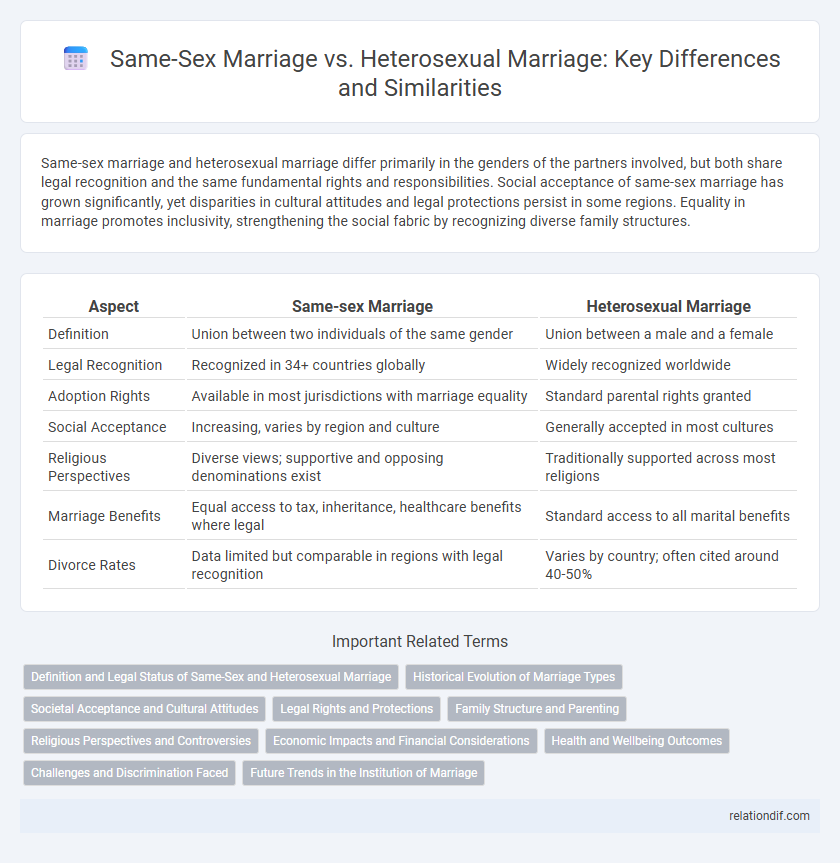Same-sex marriage and heterosexual marriage differ primarily in the genders of the partners involved, but both share legal recognition and the same fundamental rights and responsibilities. Social acceptance of same-sex marriage has grown significantly, yet disparities in cultural attitudes and legal protections persist in some regions. Equality in marriage promotes inclusivity, strengthening the social fabric by recognizing diverse family structures.
Table of Comparison
| Aspect | Same-sex Marriage | Heterosexual Marriage |
|---|---|---|
| Definition | Union between two individuals of the same gender | Union between a male and a female |
| Legal Recognition | Recognized in 34+ countries globally | Widely recognized worldwide |
| Adoption Rights | Available in most jurisdictions with marriage equality | Standard parental rights granted |
| Social Acceptance | Increasing, varies by region and culture | Generally accepted in most cultures |
| Religious Perspectives | Diverse views; supportive and opposing denominations exist | Traditionally supported across most religions |
| Marriage Benefits | Equal access to tax, inheritance, healthcare benefits where legal | Standard access to all marital benefits |
| Divorce Rates | Data limited but comparable in regions with legal recognition | Varies by country; often cited around 40-50% |
Definition and Legal Status of Same-Sex and Heterosexual Marriage
Same-sex marriage is legally recognized in numerous countries, granting couples equal rights, benefits, and responsibilities as heterosexual marriages under the law. Heterosexual marriage, traditionally defined as a union between a man and a woman, has long been the predominant form of legal marriage worldwide. Legal status varies significantly, with some regions fully recognizing same-sex marriage, while others restrict marriage rights exclusively to heterosexual couples.
Historical Evolution of Marriage Types
Marriage has evolved significantly from traditional heterosexual unions to include the recognition of same-sex marriages, reflecting broader social and legal transformations. Landmark milestones such as the legalization of same-sex marriage in countries like the Netherlands in 2001 and the United States in 2015 illustrate the shift toward marriage equality. This evolution highlights changing societal norms and the expansion of marital rights beyond gender-specific frameworks.
Societal Acceptance and Cultural Attitudes
Same-sex marriage has gained increasing societal acceptance and legal recognition in many countries, reflecting a shift towards inclusivity and equal rights. Cultural attitudes continue to evolve, with significant variations across regions influenced by religious beliefs, traditional norms, and generational perspectives. Heterosexual marriage remains widely accepted and often reinforced by longstanding cultural and societal frameworks, although debates on gender roles and equality persist within these unions.
Legal Rights and Protections
Same-sex marriage and heterosexual marriage both grant couples similar legal rights and protections, including inheritance, tax benefits, and spousal healthcare decisions. Legal recognition of same-sex marriages varies by country and state, impacting rights such as adoption, immigration, and survivor benefits. Ongoing legal challenges and reforms continue to equalize protections, ensuring nondiscrimination and equal treatment under the law for same-sex couples.
Family Structure and Parenting
Same-sex marriage and heterosexual marriage each shape family structure and parenting dynamics uniquely, with same-sex couples often creating diverse, inclusive households through adoption, surrogacy, or blended families. Research highlights that children raised in same-sex families exhibit comparable psychological well-being, social adjustment, and academic success to those in heterosexual families. Legal recognition of same-sex marriage further supports equitable parenting rights, ensuring stability and security for families regardless of parental gender composition.
Religious Perspectives and Controversies
Religious perspectives on same-sex marriage vary significantly, with many conservative faiths opposing it based on traditional interpretations of sacred texts, while progressive religious groups embrace marriage equality as an expression of love and justice. The controversy often centers around scriptural authority, doctrinal beliefs, and the interpretation of marriage as a sacred institution, creating deep divides within and between religious communities. Legal recognition of same-sex marriage challenges longstanding religious doctrines, sparking debates on religious freedom, civil rights, and the separation of church and state.
Economic Impacts and Financial Considerations
Same-sex marriage generates significant economic benefits through increased wedding industry revenue and enhanced legal protections that improve financial stability for couples. Heterosexual marriage also contributes substantially to the economy but often lacks the same level of recent growth driven by newly recognized same-sex unions. Both forms of marriage impact household wealth accumulation and access to spousal benefits, influencing broader economic patterns such as housing markets and healthcare expenditures.
Health and Wellbeing Outcomes
Same-sex marriages demonstrate comparable mental health benefits and relationship satisfaction as heterosexual marriages, with studies indicating lower rates of depression and anxiety among partnered individuals regardless of sexual orientation. Legal recognition of same-sex marriage contributes to improved access to healthcare, social support, and overall wellbeing, reducing minority stress experienced by LGBTQ+ couples. Heterosexual marriages also yield positive health outcomes through social stability and emotional support, but inclusivity in legal frameworks ensures equitable health benefits across diverse populations.
Challenges and Discrimination Faced
Same-sex marriages often encounter legal obstacles, social stigma, and lack of recognition in numerous countries, impacting access to spousal benefits, adoption rights, and inheritance laws. Heterosexual marriages, while generally enjoying broader legal protections, can still face challenges related to gender roles and societal expectations. Discrimination against same-sex couples frequently manifests in workplace bias, religious opposition, and unequal treatment in healthcare settings.
Future Trends in the Institution of Marriage
Future trends in the institution of marriage indicate growing acceptance and legal recognition of same-sex marriage worldwide, reflecting broader societal shifts toward inclusivity and equality. Demographic studies reveal increasing rates of same-sex couples choosing to marry, influencing family structure dynamics and legal frameworks. Advances in social policies and cultural attitudes suggest that marriage will continue evolving as a flexible institution accommodating diverse partnerships beyond traditional heterosexual norms.
Same-sex Marriage vs Heterosexual Marriage Infographic

 relationdif.com
relationdif.com